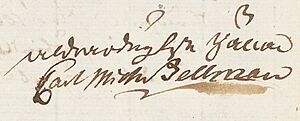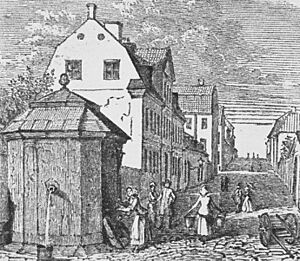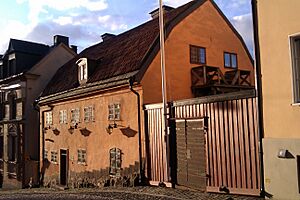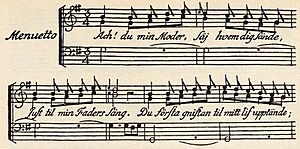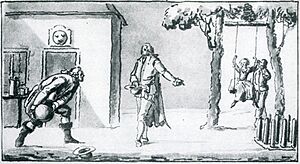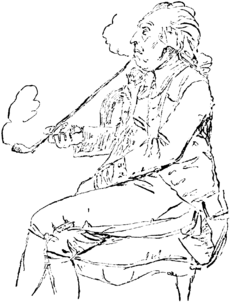Carl Michael Bellman facts for kids
Quick facts for kids
Carl Michael Bellman
|
|
|---|---|

Bellman playing the cittern,
in a portrait by Per Krafft, 1779 |
|
| Born | 4 February 1740 Stockholm, Sweden
|
| Died | 11 February 1795 (aged 55) Stockholm, Sweden
|
| Known for | Poetry, song |
|
Notable work
|
Fredman's epistles Fredman's songs |
| Patron(s) | King Gustav III |
Carl Michael Bellman (born February 4, 1740 – died February 11, 1795) was a famous Swedish songwriter, composer, musician, and poet. He is a very important person in Swedish music and literature, even today.
Bellman is best known for two collections of songs: Fredman's Epistles and Fredman's Songs. Each collection has about 70 songs. These songs cleverly mix words and music to show many different feelings and moods. They can be funny, sad, romantic, or even a bit silly.
King Gustav III of Sweden was one of Bellman's supporters. The King called him a master at making up songs on the spot. Bellman's songs are still performed and recorded by musicians today, not just in Sweden but also in other languages like English and German. Many Swedes know some of his songs by heart, like Gubben Noak and Fjäriln vingad. There is also a museum about him in Stockholm and a group that helps keep his work alive.
Contents
Biography
Early Life
Carl Michael Bellman was born on February 4, 1740, in Stockholm, Sweden. His family lived in a nice house called the Stora Daurerska house. His father, Johan Arndt Bellman, worked for the government, and his mother, Catharina Hermonia, was the daughter of a local priest.
When Carl Michael was four, his family moved to a smaller house. He went to a local school for a short time, but mostly learned from private teachers at home. He was the oldest of 15 children. His parents hoped he would become a priest. After he got over a fever, he found he could easily make up rhymes. He had a tutor named Ennes who taught him French, German, Italian, English, and Latin. He also learned to write poetry and translate hymns. He knew many Bible stories, which he later used in his songs.
Bellman's family faced money problems. In 1757, they sent Carl Michael to work at Sweden's central bank, the Riksbanken. He wasn't good with numbers and preferred to spend time in taverns, which later became a big part of his songs.
His banking job didn't work out. In 1758, he went to Uppsala University for one term. He didn't like lectures any more than banking. However, he met young men from rich families and started to entertain them with his songs. Bellman returned to the bank but quickly got into financial trouble. In 1763, he moved to Norway for a short time because of his debts. The bank later found that Bellman was spending too much time on fun activities instead of work, so he left his job.
Poetry and Song
In 1765, Bellman's parents passed away. He wrote a religious poem about his feelings. After this, his luck improved. He found new jobs, first in a manufacturing office and then in customs. This allowed him to live happily in Stockholm again with a steady income. In 1768, he started creating the special songs he is famous for today.
Bellman mostly played the cittern, a stringed instrument. He became the most famous cittern player in Sweden. His first songs were "parody songs," which were popular at the time. These songs often took well-known tunes and gave them new, funny lyrics.
Between 1769 and 1773, Bellman wrote most of his Epistles and many other poems. He tried to publish them in 1772, but King Gustav III of Sweden was busy with a political change. He finally got permission in 1774. However, the cost of printing, especially with the music, was too high for him. In 1776, the King gave him a special job as secretary to the national lottery. This job paid him and supported him for the rest of his life.
On December 19, 1777, when he was 37, Bellman married Lovisa Grönlund, who was 22. They had four children: Gustav, Elis, Karl, and Adolf. Sadly, Elis died young.
Bellman also wrote religious poems throughout his life. He published collections of these poems in 1781 and 1787. He wrote about ten plays, which were mostly for entertainment. In 1783, Bellman published The Temple of Bacchus (Bacchi Tempel). He hoped this would make him known as a serious poet, but people still saw him as a unique and fun entertainer.
Bellman's most important works are the 82 Fredman's Epistles (published in 1790) and the 65 Fredman's Songs (published in 1791). His songs talk about themes like love, life, and how quickly time passes. They show life in Stockholm in the 1700s. They also often mention characters from Greek and Roman stories, like the goddess of love, Venus, or the god of wine, Bacchus. Fredman's Songs also include figures from the Old Testament like Noah.
Bellman made his songs funny and elegant by putting unexpected things together. For example, one song might start with a beautiful goddess, but then she turns into a fun-loving person from a tavern. The songs are set to music in a very clever way. The music and words work together to create strong pictures and feelings. Even though his songs seem like they were made up on the spot, they are actually very carefully put together.
Bellman was also a talented entertainer. He could imitate many different people and sounds at once. People who heard him thought a whole crowd had burst into the next room!
In 1790, the Swedish Academy gave Bellman a prize for his literature. Even though his Fredman's Epistles were not typical literature, the King and a famous poet helped him win the award.
Later Life
After King Gustav III was assassinated in 1792, support for artists decreased. Bellman, who was already not well, became sicker. He caught tuberculosis, a disease that had also killed his mother. By the winter of 1792, he was seriously ill.
He also faced money problems throughout his life. At one point, he was even put in prison for a small debt. On February 11, 1795, Bellman passed away in his sleep in his home in Stockholm. He was buried in Klara churchyard, but the exact spot is now unknown. In 1851, the Swedish Academy placed a memorial in the churchyard with a bronze medallion to remember him.
Legacy
Performance and Recordings
Bellman's songs continued to be popular throughout the 1800s. They were sung by city people, in clubs, and even by ordinary people in the countryside. His Epistles and Songs were published in small books and performed at festivals and concerts. Characters from his songs, like Fredman and Ulla Winblad, were even painted on tavern walls and put on souvenirs like plates and mugs.
Many musicians have performed Bellman's songs. Some famous interpreters include Sven-Bertil Taube and Fred Åkerström. His songs have also been recorded as rock music and choral pieces.
Translations
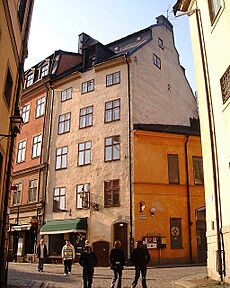
Bellman's songs have been translated into at least 20 languages, including English and German. Even the German Communist leader Karl Liebknecht liked Bellman's songs and translated some into German. Hans Christian Andersen was one of the first to translate Bellman into Danish. Bellman's songs have been translated and recorded in Icelandic, Italian, French, Finnish, Russian, and Yiddish. Many Swedish schoolchildren still learn some of his songs by heart today.
Several books in English have been written with translations of Bellman's work. These include books by Paul Britten Austin and Hendrik Willem van Loon. Britten Austin also wrote a detailed book about Bellman's life.
Other Legacies
Bellman was the subject of a ballet in 1844. He also appears as a character in a Swedish television series. Bellman has been featured on Swedish postage stamps several times, celebrating his birth anniversaries. A street in Stockholm, Bellmansgatan, is named after him.
Swedish schoolchildren sometimes tell "Bellman jokes." These jokes are about a made-up character named Bellman, who is a bit of a trickster. These jokes have little to do with the real poet.
Bellmanmuseet
Stora Henriksvik, also known as the Bellman museum, has a small exhibition about his life and work. It features paintings and replica objects. The museum is located in a 17th-century house in Stockholm. This place is even mentioned in one of Bellman's songs, Epistle No. 48, Solen glimmar blank och trind.
Bellmansällskapet
The Bellman Society (Bellmansällskapet) was started in Stockholm in 1919. This group helps people learn more about Bellman and his work. They organize concerts, talks, and trips. They also publish books and recordings of Bellman's songs. There are similar Bellman societies in other countries like Denmark and Germany.
Works
Bellman published the following works:
- Månan (The Moon), 1760
- Bacchi Tempel (Temple of Bacchus), 1783
- Fredmans Epistlar (Fredman's Epistles), 1790
- Fredmans Sånger (Fredman's Songs), 1791
- Samlade verk (Collected Works)
See also
 In Spanish: Carl Michael Bellman para niños
In Spanish: Carl Michael Bellman para niños


